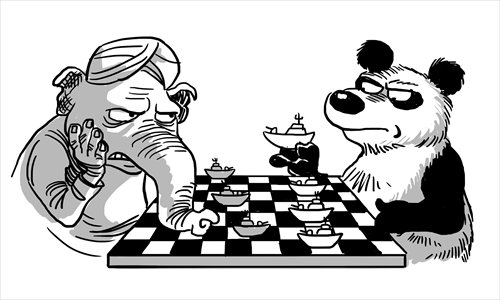China and India jostle in Indian Ocean

Sino-Indian rivalries will be watched closely for years, perhaps decades to come. They are part of the affairs that are going to dominate the 21st century and influence world events.
There is one core area of divergence, if not conflict. China is not an Indian Ocean power and yet it is investing a lot of diplomatic and military capital into becoming one. In retaliation, India, which is not a power in the South China Sea or East China Sea, is working overtime to project itself as one. This is the crux of Sino-Indian strategic rivalries.
Rivalries in the Indian Ocean and the Asia-Pacific region are not limited to China and India. Other East Asian powers like Japan, South Korea, Singapore, Malaysia, the Philippines and Vietnam are also pro-actively involved in strategic one-upmanship in both regions. This has given rise to a new coinage in the strategic world, the "Indo-Pacific," linking two regions once as different as chalk and cheese.
Ironically, East Asia is currently in a tailspin largely because of China putting a laser-beam focus on the South China Sea and East China Sea from 2009 onward. Unlike East Asian powers, India has no territorial claims in the South China Sea and the East China Sea, and yet New Delhi would be ignoring its strategic interests by remaining a passive watcher.
In many ways, the South China Sea and Indian Ocean are strategically interrelated. The presence of a maritime power in one international water body inevitably increases its leverage in the other international water body. While China has been arguing that, despite the name, the Indian Ocean doesn't belong to India alone, India and other countries can equally contend that South China Sea too does not belong to China alone.
The Chinese strategic imperatives are not very different. China looks at South China Sea as a core area in its strategic matrix. It does not want foreign powers, particularly the US, to have a military presence in this area. From the Chinese perspective, it is not just a matter of the hydrocarbon potential of the region, but a much larger issue.
The other powers, particularly the US and Japan, will have none of this. It is not for nothing that the US has started relocating 40 percent of its naval assets and personnel to this region. Therefore, what one is seeing on the Asian maritime chessboard is interesting and intriguing moves and counter-moves.
It is against this backdrop that the Indians are busily reworking their strategies toward island nations in the Indian Ocean. Their actions, Indian strategists insist, are mainly reactive, not proactive. They say that they are forced to react to a Chinese strategic juggernaut unrelentingly hurtling toward their backyard. The much-hyped Chinese "String of Pearls" strategy is outdated. Now it is time for safeguarding national interests as the Chinese juggernaut is leaving fewer options.
The new Indian strategy can be broadly summed up as having two tenets: safeguarding and further boosting Indian strategic interests in the Indian Ocean region, combined with forays into the Asia-Pacific region and forging closer ties with countries that constitute China's backyard.
The latter has already been happening at a rather rapid pace as India has intensified its engagement with countries such as Japan, South Korea, Singapore and Vietnam. As far as the former is concerned, India's recent Maldives strategy is a case in point. The tiny island nation is seen by the Indians as a pivotal spot to ensure that India remains a dominant force in the Indian Ocean region. The Maldives serves as an important link between the sea lanes of East Asia and the Middle East. China's recent announcement of a $500 million package of economic assistance to the Maldives and its vigorous outreach to countries like Seychelles, Mauritius and Sri Lanka has not gone unnoticed in New Delhi.
Maldives, a country situated in the Indian Ocean where China has significantly enlarged its strategic footprints, has of late popped up on the front burner of the Indian strategic establishment. Indian Defense Minister AK Antony, who is now virtually the No.2 in the Manmohan Singh government after Pranab Mukherjee quit the government to become the country's president, visited the Maldives last month.
During this visit, Antony announced his government's twin decisions of stationing a defense attaché in Male, the capital of Maldives, and positioning its advanced light helicopters, the Dhruv, for an additional period of two years beyond April 2012. Incidentally, the Dhruv was recently brought back to Hindustan Aeronautics Limited's workshop in Bangalore for an overhaul and has now been upgraded with night flying capabilities.
For seasoned strategic watchers, the "Indo-Pacific" is the new region to watch out for. The new power games there are already underway.
The author is a New Delhi-based journalist-author and a strategic analyst. bhootnath004@yahoo.com